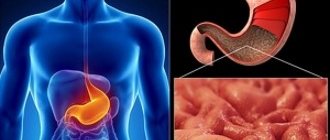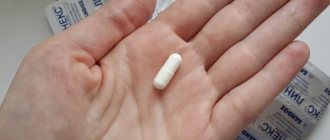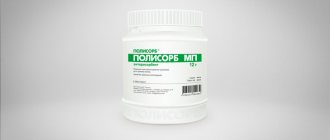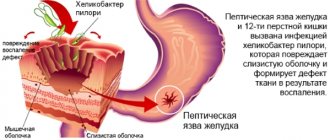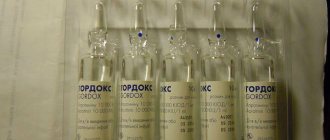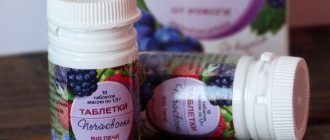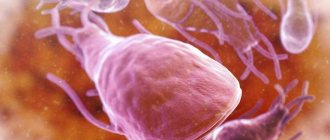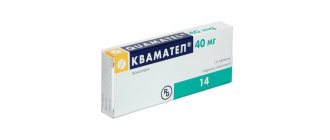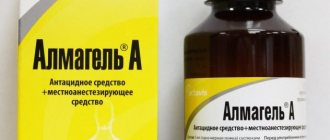From this article you will learn:
- composition analysis,
- detailed instructions for use,
- Solcoseryl gel – reviews, price 2022.
The article was written by a specialist with higher medical education.
Solcoseryl gel is a drug based on deproteinized dialysate from the blood of calves, which accelerates the healing of wounds on the skin and mucous membrane. For example, this drug is widely used in dentistry - to accelerate the healing of erosions and ulcers of the mucous membrane during stomatitis, traumatic injuries to the mucous membrane, and for bedsores under dentures. As for skin wounds, the drug is intended only for the treatment of fresh, wet wounds. To treat wounds and skin damage in the absence of wet discharge, Solcoseryl should be used in the form of an ointment.
The drug is manufactured (Switzerland) and registered as a “medicinal product”. The drug has a high safety profile - in particular, it has no age restrictions, as well as contraindications for use in pregnant and lactating women. When squeezed out of the tube, you can see that the gel is completely transparent, homogeneous and not too liquid (it has a fairly dense consistency). It also has a faint smell of meat broth, which is due to the production technology.
Solcoseryl: photo of packaging
Compound
The composition of 1 ml of solution for injection includes 42.5 mg of the active substance solcoseryl (deproteinized dialysate from the blood of dairy calves) and water for injection as an auxiliary component.
1 g of eye gel contains 8.3 g of the active substance solcoseryl (deproteinized dialysate from the blood of dairy calves) and auxiliary ingredients: sodium carboxymethylcellulose, sorbitol, water for injection, benzalkonium chloride.
1 g of Solcoseryl ointment contains 2.07 mg of the active substance solcoseryl (deproteinized dialysate from the blood of dairy calves) and a number of auxiliary components: methyl parahydroxybenzoate, propyl parahydroxybenzoate, cetyl alcohol, cholesterol, white petrolatum, water for injection.
Solcoseryl gel – price, composition analysis
As in the situation with other drugs in the Solcoseryl line, the price for the gel form increased by 3-4 times in 2020-2022. What is the reason for this increase is not entirely clear to me, as a practicing doctor (after all, the drug has a very simple composition). For Solcoseryl gel the price will be from 2000 to 2700 rubles - in 2022). The drug is available in aluminum tubes of 20 g. It is sold in pharmacies without a prescription.
Composition of Solcoseryl gel:
| The active substance (per 1 g of gel) is deproteinized dialysate from the blood of healthy dairy calves. | 4.15 mg |
| Excipients - calcium lactate penhydrate, propylene glycol, sodium carmellose, water for injection, as well as preservatives - methyl parahydroxybenzoate (E 218) and propyl parahydroxybenzoate (E 216). | |
Composition analysis - the only active component of the gel is deproteinized dialysate from the blood of dairy calves, which is rich in a large number of low molecular weight organic compounds - amino acids, glycolipids, oligopeptides, nucleosides, etc. Studies have shown that this composition of organic compounds in Solcoseryl gel accelerates the healing process by approximately 30%. The latter is achieved, among other things, by stimulating angiogenesis and fibroblast function in damaged tissues.
Among the auxiliary components, you can pay attention to the preservatives - methyl parahydroxybenzoate (E218) and propyl parahydroxybenzoate (E216). They belong to a class of preservatives called parabens. As part of the gel, they cannot harm the body, but sometimes cause allergic reactions. You should be careful here only if you have severe allergic reactions to cosmetics and oral hygiene products, in which parabens are most often used.
Analogues –
Previously, Russian pharmacies sold the drug Actovegin, identical in composition, in the form of a jelly, which also contained dialysate from the blood of dairy calves (at the moment this form of the drug is no longer sold in Russia). Solcoseryl gel has no other direct analogues, but there are drugs with an excellent composition and similar effects.
All analogues can be divided into 2 groups. The first group of drugs are drugs for external use, intended to accelerate the healing of wounds on the skin (here we include Olazol and Bepanten). Preparations of the second group are products that are intended for use on the moist mucous membrane of the oral cavity (for example, Curasept “ADS 350 Regenerative” and “GengiGel” gel).
- OLAZOL (in the form of an aerosol) - this drug is suitable for accelerating the epithelization of skin wounds. It contains chloramphenicol, sea buckthorn oil and benzocaine (an anesthetic). Moreover, it not only accelerates tissue healing, but also has an antibacterial and analgesic effect, and also reduces the release of exudate from the wound. Due to the presence of an antibacterial effect, the drug can be used to treat infected wet wounds on the skin. The cost of the drug Olazol will be from 220 rubles.
- Cream BEPANTHEN PLUS – because Solcoseryl gel is intended for the treatment of wet wounds, then from the entire line of Bepanten preparations, we can only use Bepanten Plus cream on wet wounds. This drug contains 5% dexpanthenol (a precursor to vitamin B5, which stimulates skin regeneration), as well as the antiseptic chlorhexidine, which has an antimicrobial effect, thereby reducing the risk of infection. It is important that the concentration of chlorhexidine in Bepanten Plus cream is 0.5% (analogs are much lower). On wet wounds, it is most effective to apply the drug on turundas under a bandage - 2 or more times a day. Open treatment of wet wounds will be ineffective. The cost of Bepanten Plus cream is about 470 rubles for a 30 g tube, and a 100 g tube will cost about 950 rubles.
- CURASEPT “ADS 350 Regenerative” gel is designed to accelerate the healing of the oral mucosa. Contains hyaluronic acid to accelerate the healing of ulcers and wounds, as well as the PVP-VA complex, which forms a protective film on wound surfaces and ulcers (this protects their surface from irritants and also accelerates healing). It also contains the antiseptic chlorhexidine 0.5%. The cost of the gel is about 650 rubles - per 30 ml tube. Be careful when purchasing, because... in the Curasept line there is a gel with a similar name, but without hyaluronic acid.
- Oral gel "GengiGel" (GengiGel) is a gel for the mucous membrane of the gums and oral cavity, which contains 0.2% hyaluronic acid + xylitol. We have already said above that hyaluronic acid has a wound-healing effect. Unfortunately, in Russia this drug costs much more than the previous one (more than 1800 rubles for a 20 ml tube), and this despite the fact that its concentration of hyaluronic acid is much lower.
pharmachologic effect
Solcoseryl is a medicine that affects mainly metabolic processes in tissues. They activate tissue metabolic processes, improve trophism and stimulate tissue repair and regeneration when exposed to damaging factors.
Solcoseryl in injection form belongs to the pharmacotherapeutic group of hemodialysates and hemofiltrates, ointment and jelly - to the category of drugs used to treat wounds and ulcers (including poorly healing ones), gel - to the category of drugs used to treat ophthalmological diseases.
Pharmacodynamics and pharmacokinetics
The main component of Solcoseryl preparations are fractions of the blood of calves with natural low-molecular substances included in their composition, the molecular weight of which does not exceed 5000 daltons.
To date, its properties have only been partially studied. In vitro tests, as well as preclinical and clinical studies, have shown that calf blood extract:
- promotes the restoration and/or maintenance of aerobic metabolism and oxidative phosphorylation processes, and also ensures the replenishment of cells that do not receive sufficient nutrition with high-energy phosphates;
- in vitro enhances the utilization of oxygen and activates the transport of glucose into tissues and cells suffering from hypoxia and metabolically depleted;
- helps improve repair and regeneration processes in damaged tissues that do not receive sufficient nutrition;
- prevents the development or reduces the severity of secondary degradation and pathological changes in reversibly damaged cells and cellular systems;
- in in vitro models activates collagen synthesis;
- has a stimulating effect on the proliferation (reproduction) of cells and their migration (in in vitro models).
Thus, Solcoseryl protects tissues that are in a state of oxygen starvation and nutritional deficiency, and accelerates the processes of their restoration and healing.
Solcoseryl eye gel is a dosage form that was developed specifically for the treatment of damage to the stroma of the cornea.
The gel-like consistency of the product ensures its uniform distribution on the cornea, and good adhesive properties allow it to remain on it for a long period of time. The use of eye gel accelerates the restoration of damaged tissues and prevents scarring.
The rate and extent of absorption, distribution, as well as the rate and route of elimination of the active substance from the patient’s body cannot be determined using conventional pharmacokinetic methods, since protein-free calf blood extract has pharmacodynamic effects that are characteristic of molecules with different chemical and physical properties.
In the process of studying the pharmacokinetic characteristics of Solcoseryl solution in animals, it was found that after a bolus injection, the effect of the drug develops within half an hour. The effect lasts for three hours after administration of the solution.
Indications for use
Solcoseryl injections - what are they for and what groups of patients are they prescribed for?
Solcoseryl in ampoules is indicated for patients who have been diagnosed with occlusive peripheral artery disease of the third or fourth degree according to the Fontaine classification and who have contraindications or intolerance to other vasoactive drugs.
It is also prescribed to patients with chronic venous insufficiency , which is accompanied by the formation of treatment-resistant trophic ulcers , as well as to patients with disorders of cerebral metabolism.
What is Solcoseryl ointment and jelly for?
The use of ointment and jelly is advisable for the treatment of minor injuries (for example, abrasions or cuts), frostbite, first and second degree burns (thermal or solar), difficult-to-heal wounds (for example, trophic skin disorders of venous etiology or bedsores ).
Indications for use of eye gel
Solcoseryl eye gel is recommended:
- for the treatment of mechanical injuries and erosive damage to the cornea and conjunctiva;
- to accelerate the healing processes of postoperative scars in the postoperative period (for example, after a cornea transplant, surgery to remove a cloudy lens, surgical treatment of glaucoma , etc.);
- for the treatment of burns of the cornea of various origins (thermal, chemical or radiation);
- for the treatment of ulcerative lesions of the cornea and keratitis of various etiologies;
- for dystrophic lesions of the cornea of various etiologies, including neuroparalytic keratitis , endothelial-epithelial dystrophy ( bullous keratopathy ), etc.;
- for the treatment of corneal xerophthalmia with lagofatalmos (non-closure of the palpebral fissure);
- to improve the tolerability of contact lenses and reduce the time of adaptation to them.
Indications for use of Solcoseryl dragees
The drug in the form of pills is taken to treat trophic and radiation ulcers , bedsores , gangrene , and chronic venous insufficiency . They are also prescribed to patients with gastric and duodenal ulcers and to patients who require skin and/or corneal grafting procedures.
Contraindications
Administration of the solution is contraindicated in patients with known hypersensitivity to calf blood dialysates. The solution is also contraindicated for atopy and for persons allergic to milk.
Since the ointment, jelly and solution contain derivatives of parahydroxybenzoic acid , which are used as preservatives, as well as trace concentrations of benzoic acid in free form, it is not used in the presence of allergic reactions to the above substances.
Ointment and jelly should be prescribed with caution to persons with a predisposition to allergic reactions.
A contraindication to the use of eye gel is hypersensitivity to its components. Since the eye gel can cause temporary visual impairment, you should not drive a car or operate potentially dangerous machinery for half an hour after its use.
Indications
For dental purposes, this medication is prescribed in the following cases:
- Burns of the mucous membrane.
- Mechanical damage to the gums.
- After tooth extraction.
- Stomatitis.
- Pimples on the gums.
Among the contraindications, the only contraindications can be noted: individual intolerance to the active substances. It is recommended to use only as prescribed by a doctor.
Please note that Solcoseryl is powerless as an independent treatment. The drug does not have antimicrobial properties, so before using the product it is necessary to disinfect the gum area with an antiseptic.
Side effects
Administration of Solcoseryl IV or IM in very rare cases (their frequency does not exceed 0.1%) provokes the development of allergic or anaphylactic reactions, which are most likely caused by class E immunoglobulins.
If body temperature rises, urticaria , swelling and hyperemia at the site of drug administration, the use of Solcoseryl is stopped, and symptomatic treatment will be prescribed to eliminate the symptoms that appear.
Since the solution contains potassium, its administration may cause pain at the injection site.
When using Solcoseryl cream, a short-term burning sensation may be felt at the site of application. Discontinuation of the drug is required only in cases where the unpleasant sensation does not disappear for a long period of time.
In isolated cases, the use of jelly and ointment can cause the development of allergic reactions. If allergy symptoms appear, the use of these products should be discontinued.
Toxicological studies of Solcoseryl eye gel have shown the high safety of this drug when used for its intended purpose in accordance with the instructions.
After instillation of the product, a short-term burning sensation and mild irritation may be observed, which are not reasons for stopping treatment. Repeated instillations in rare cases provoke the development of allergic reactions (a similar effect is also observed during treatment with other ophthalmic drugs for topical use).
Use of the drug Solcoseryl solution for injection
Adults are prescribed 5–10 ml/day IM or IV daily. For severe burns or trophic ulcers, adults are prescribed 10–20 ml/day, but not more than 850 mg/day, preferably in the form of intravenous or intravenous drip infusions (250 ml of 5% glucose solution or isotonic solution is used as a solvent). sodium chloride solution). The duration of treatment can be 4 weeks. In mild cases, only local treatment is recommended, but for the healing of severe trophic lesions, combined treatment with Solcoseryl (parenteral administration and local application) is necessary.
Instructions for use of Solcoseryl (Method and dosage)
Solution for injection, instructions for use
In cases where the patient's condition allows, the drug is recommended to be used in the form of an injection solution diluted at least 50:50 with saline or glucose solution.
Solcoseryl in ampoules is intended for slow administration in the form of intravenous injections or infusions. If intravenous administration is not possible, the drug can be injected into the muscle.
Since the drug in its pure form is a hypertonic solution, it should be administered slowly.
For intravenous infusion, the drug should be pre-diluted with 0.25 l of 0.9% NaCl solution or 5% glucose solution. Solcoseryl solution is administered intravenously by drip. The rate of administration depends on the hemodynamic status of the patient.
Patients with occlusive disease of peripheral arteries of the third or fourth degree according to the Fontaine classification are shown daily injection into a vein of 0.85 g (or 20 ml of undiluted solution) Solcoseryl.
The duration of use is usually up to four weeks and depends on the clinical situation.
Patients with chronic venous insufficiency , which is accompanied by the formation of treatment-resistant trophic ulcers , are indicated for intravenous administration of 0.425 g (or 10 ml of undiluted solution) Solcoseryl three times a week.
The duration of the course of treatment should not exceed four weeks (it is determined depending on the nature of the disease).
To prevent the appearance of peripheral venous edema , therapy is supplemented by applying a pressure bandage using an elastic bandage. If the patient has skin trophic disorders, treatment is carried out by combining injections or infusions of Solcoseryl solution with the use of jelly, and then ointment.
Patients who have suffered ischemic or hemorrhagic stroke are prescribed daily intravenous administration of 0.425 or 0.85 g of Solcoseryl (10 or 20 ml of undiluted solution) as the main course. The duration of the main course is 10 days.
Further treatment involves daily administration of 85 mg (or 2 ml of undiluted solution) Solcoseryl for one month.
In severe forms of brain contusions, daily injection of 1000 mg of Solcoseryl into a vein (corresponding to 23-24 ml of undiluted solution) is prescribed for 5 days.
The drug is administered intramuscularly undiluted at a dose of 2 ml/day.
Solcoseryl jelly and ointment: instructions for use
Cream and ointment are intended for application directly to the wound surface. Before using these dosage forms, the wound is first cleaned using a disinfectant solution.
Patients with trophic ulcers , as well as in cases of purulent infection of wounds, require preliminary surgical treatment before starting treatment.
When using jelly and ointment for frostbite , as well as for treating ulcers and skin injuries, it is important to remember that only sterile dressings should be used to treat damaged areas.
The gel is intended for application to fresh (including wet) wounds and weeping ulcers. The product is applied in a thin layer to a previously cleaned wound surface two or three times a day.
To treat areas where epithelization has begun, the use of ointment is indicated. The use of jelly is advisable until pronounced granulation tissue begins to form on the damaged surface of the skin and the wound begins to dry out.
The ointment is used primarily to treat dry wounds. The product is applied in a thin layer to a previously cleaned wound surface once or twice a day. If necessary, cover the treated surface with a bandage.
The course of treatment with the drug in this dosage form continues until the wound heals and is completely healed with elastic tissue.
For patients with severe trophic damage to the skin and soft tissues, it is recommended to combine jelly and ointment with the injection form of Solcoseryl.
Experience with the use of jelly and ointment for children is limited.
The drug does not have such release forms as suppositories. However, in the complex therapy of chronic colitis (inflammation of the colon), microenemas with Solcoseryl jelly are often prescribed.
Before use, the jelly contained in the tube (all 20 g) is added to 30 ml of warm water and after the enema procedure, which is carried out to cleanse the intestines, it is administered daily for 10 days.
Solcoseryl eye gel, instructions for use
Unless otherwise instructed by the attending physician, the eye gel is instilled into the conjunctival cavity, one drop three or four times a day. It is recommended to use the product daily until complete recovery.
In particularly difficult cases, eye ointment can be used one drop per hour. If the patient is simultaneously prescribed eye drops and Solcoseryl eye gel, the gel should be applied approximately half an hour after the drops.
During the period of adaptation to contact lenses, the drug is instilled into the conjunctival cavity immediately before installing the lenses and immediately after removing them.
Dragee Solcoseryl: instructions for use
The instructions recommend taking 100 mg tablets three times a day.
How to use the ointment
Instructions for use of solcoseryl include the following recommendations:
- the ointment is applied only topically directly to the wound, covering those areas where the healing process has begun;
- the wound surface is pre-cleaned with disinfectant solutions, since the ointment does not contain antibacterial components;
- in case of purulent infection, cleanse from exudate and dead tissue;
- ointment is prescribed for the treatment of injuries with clear signs of healing;
- apply solcoseryl to the surface of the wound in the morning and evening, apply a bandage if necessary;
- Treatment should be continued until the wound is completely scarred.
The use of solcoseryl is determined by the type of pathology. Thus, for chronic trophic ulcers, it is recommended to treat the inner surface with solcoseryl gel, and the outer edges of the wound with ointment 2 times a day for 3 weeks. For diabetic feet without exudate, the ointment is applied twice a day for 2 months.
In proctology, solcoseryl ointment has only positive reviews from patients. This is due to the fact that the drug promotes rapid tissue healing and stimulates blood supply in damaged vessels. However, the ointment can be used only for external forms of hemorrhoids, which are not accompanied by the formation of anal fissures (in this case, it is more appropriate to prescribe solcoseryl gel). The drug is applied to hemorrhoids 4-5 times a day for a week.
The nuances of using the ointment:
- The drug should not be used by pregnant women or during lactation, since appropriate clinical trials have not been conducted;
- if pain appears in the wound area, redness of the skin around the injury, exudate, or elevated body temperature, you should consult your doctor;
- If there are no signs of wound healing within 2-3 weeks of use, you should immediately consult a doctor, as this may indicate a benign or malignant wound process.
special instructions
Studies regarding the safety of using Solcoseryl solution for the treatment of children have not been conducted, therefore the drug is not recommended for the treatment of children under the age of 18 years.
Experience in treating children with the use of eye gel and topical dosage forms of the drug is also limited.
Solcoseryl in ampoules should be administered separately from other drugs (it is especially incompatible with phytoextracts). The exceptions are isotonic 0.9% NaCl solution and 5% glucose solution. It is also not recommended to dilute the product in potassium-containing solutions for infusion.
Eye gels are characterized by the ability to stick to contact lenses, so it is recommended to stop wearing lenses during treatment with the drug.
If allergic reactions associated with the use of the drug occur, you should immediately report them to your doctor. If the drug is used to treat an infectious disease of the cornea, therapy is supplemented with the prescription of appropriate antimicrobial agents.
Avoid contact of the gel with soft contact lenses as it may discolor them.
If necessary, treatment with Solcoseryl can be supplemented with antibacterial, vasodilating and other drugs.
Solcoseryl in cosmetology: for the face, hands, rough elbows and heels, for the skin around the eyes
In medicine, Solcoseryl preparations are used to accelerate the healing of damaged skin; in home cosmetology, they are used as a remedy for acne, stretch marks, and wrinkles. They are used to soften the skin, increase its turgor, improve complexion and eliminate acne .
In cosmetology, the ointment can be used as a stand-alone product (it is applied pointwise to problem areas, in the form of a mask once a week before bedtime and two to three times a week on the skin around the eyes), or in combination with other products, in particular with the drug Dimexide . Let's look at how to use these medications together.
For the face, Dimexide and Solcoseryl are used as follows: on the face, neck and décolleté, previously cleaned with peeling agents (you can also do alkaline peeling using tar soap, salt and soda), apply a solution of Dimexide with water, prepared in a ratio of 1:10 (enough dilute 5 ml (teaspoon) of Dimexide in 50 ml of water); Before the product has time to be absorbed, Solcoseryl ointment is applied to it in a thick layer.
If the gel is used in cosmetology, then the mask should be periodically sprayed with thermal water (you can also use regular water through a spray bottle). The mask is left on the face for about half an hour to an hour, then washed off and a light hypoallergenic cream is applied to the skin.
According to women who have tried this mask recipe on themselves, Solcoseryl ointment is more comfortable for the face than gel (after application, you don’t have to wash it off, just remove the residue with a napkin). In addition, it is not recommended to use a gel mask more than once a month.
Used as a remedy for wrinkles around the eyes, Solcoseryl ointment has proven itself to be a very effective remedy. Applying it like a regular cream, within a week you can see that the number of wrinkles and wrinkles has decreased, the skin has tightened and smoothed, and its color has become fresher and healthier.
Dimexide and Solcoseryl are no less effective against wrinkles, and perhaps even more effective. This is due to the ability of Dimexide to enhance the penetration of the active substance of drugs deep into the tissue. After using these products in combination, skin irregularities and imperfections disappear, and the effect of the mask is comparable to the effect of Botox .
The gel and ointment can also be used to soften rough skin on the elbows and heels. It is best to apply them to problem areas before bed.
GASTROCYTOPROTECTORS: TO PROTECT THE Gastrointestinal Mucosa
Preferanskaya Nina Germanovna Associate Professor of the Department of Pharmacology, Institute of Pharmacy named after. A.P. Nelyubin First Moscow State Medical University named after. THEM. Sechenov (Sechenov University), Ph.D.
They increase the resistance of the mucous membranes of the gastrointestinal tract to the action of increased pepsin activity or a strongly acidic reaction of the stomach (pH 0.8–1.5). Gastrocytoprotective agents stimulate the formation of mucin by glandular cells and the gastric mucosa, thereby maintaining the integrity of its protective barrier. The drugs help maintain the pH of gastric juice at a level of 3.0-3.5 by increasing the secretion of bicarbonates. When used, the synthesis of protective factors (prostaglandins) increases and their inactivation decreases. The regeneration of cells in the gastric mucosa improves by reducing microvascular damage and improving regional blood flow. Epidermal growth factor is stimulated, the barrier function of the mucous membrane is increased. Proliferation and turnover of epithelial cells are stimulated. All this significantly improves reparative processes and contributes to the restoration of desquamated (Latin desquamo - remove, peel off) epithelium in the stomach.
For this purpose, several subgroups of gastrocytoprotective drugs are used:
1. Synthetic analogues of prostaglandins - Misoprostol.
2. Drugs that increase the synthesis of prostaglandins - Rebamipide.
3. Preparations that form complex compounds (chelates) - Bismuth tripotassium dicitrate, Sucralfate.
4. Bismuth preparations: Bismuth subnitrate, Vikalin, Vikair.
5. Preparations of natural origin - Solcoseryl, Mumiyo, etc.
Gastrocytoprotective drugs differ from each other not only in composition, but also in pharmacological effects. Each drug protects the mucous membrane in different ways and stimulates the restoration of cells in the stomach wall.
HORMONE-LIKE LIPID MEDIATORS
Numerous studies have shown that prostaglandins increase the resistance of the gastric mucosa to the effects of traumatic factors (hydrochloric acid, pepsin, bile, ethanol, NSAIDs, corticosteroids). This is due to their influence on the physiological functions of the body. NSAIDs and corticosteroids disrupt the formation of prostaglandins E and I2. The first drug in this group is a synthetic analogue of prostaglandin E1 - Misoprostol - TN " Mirolyut " - activates the regeneration of the mucous membrane, increases blood circulation in the microvessels of the stomach wall, suppresses the production of the digestive enzyme pepsin and reduces the production of gastric juice It increases the reproduction of special (additional) cells of gastric mucus, which protects its walls from aggressive factors. The drug has a weak stimulating effect on the smooth muscles of the gastrointestinal tract through antisecretory activity. The stability of the gastric mucosa increases, which prevents the development of erosive and ulcerative lesions. Admission is often prescribed for the prevention of NSAID gastropathy. It is better not to prescribe Misoprostol on your own, even if aspirin was prescribed as the main medication, which for some reason many patients take off-label and quite often. In patients taking NSAIDs, the incidence of gastric and duodenal ulcers is reduced and the risk of ulcer bleeding is reduced.
Important! The drug is contraindicated in cases of coronary artery disease, hypertension, liver dysfunction, and pregnancy. Not recommended for children and adolescents. Prostaglandins have dangerous side effects, they cause: flatulence, diarrhea, nausea, headache, menstrual irregularities, vaginal bleeding, etc.
Before taking the drug, you must consult your doctor.
Rebamipid (Rebamipidum) - TN " Rebagid " - has a cytoprotective effect on the gastric mucosa under the damaging effects of ethanol, acids, alkalis and drugs (NSAIDs, GCS). Promotes the activation of enzymes that accelerate the biosynthesis of high molecular weight glycoproteins and increases the mucus content on the surface of the stomach wall. Rebamipide increases the content of prostaglandin E2 (PGE2) in the gastric mucosa and increases the content of PGI2 in the stomach. Helps improve blood supply to the gastric mucosa, activates its barrier function, activates alkaline secretion of the stomach, enhances the proliferation and metabolism of gastric epithelial cells. When taking the drug, the products of oxidative stress, inflammatory cytokines and chemokines are inhibited, while clearing the mucosa of hydroxyl radicals and suppressing superoxides produced by polymorphonuclear leukocytes and neutrophils in the presence of Helicobacter pylori. Absorption when taken orally is high. After administration at a dose of 100 mg, the maximum concentration is reached after approximately 2 hours and is 340 ng/ml. The half-life is approximately 1 hour. Repeated doses of the drug do not lead to its accumulation in the body. Approximately 10% of the drug is excreted by the kidneys, mainly unchanged.
The drug is taken orally, 1 tablet. 3 times a day, washed down with a small amount of liquid. The course of treatment is 2-4 weeks; if necessary, it can be extended to 8 weeks.
Important! When using the drug, side effects from the gastrointestinal tract may occur: constipation, flatulence, diarrhea, nausea, abdominal pain, impaired taste, as well as allergic reactions and menstrual irregularities.
medicinal products forming a protective film of organometal complexes
Bismuth tripotassium dicitrate (Bismuthi trikalii dicitras) - TN " De-nol ", TN " Novobismol ", table. 120 mg. In the acidic environment of the stomach, the drug forms insoluble bismuth oxychloride and dicitrate. The combination of dicitrate with bismuth hydroxide forms molecular complexes of various structures and sizes, which leads to the transition of the aqueous solution into a colloidal form. The colloidal form of the drug allows it to effectively penetrate into the gastric mucus. The drug penetrates well into the depths of the gastric pits, which allows it to destroy bacteria that are out of reach of other antibacterial drugs. It has an anti-Helicobacter effect, which manifests itself in the form of coagulation of microbial cell proteins and the death of the spiral-shaped flagellated gram-negative bacterium Helicobacter pylori. When used, the drug is practically not absorbed from the gastrointestinal tract and is excreted mainly in excrement.
Sucralfate (Sucralfatum) - TN " Venter ", tab. 1.0 g is a drug of mixed action: in the stomach it breaks down into two active metabolites: aluminum hydroxide, which has an antacid effect, and sucrose sulfate, which interacts with the proteins of necrotic tissue, forming a chelate complex in the form of an adhesive mass that lines and protects the ulcer from damage. Aluminum hydroxide has an antacid effect, neutralizes hydrochloric acid and increases the pH of the stomach contents. The main side effects are dyspeptic disorders and allergic reactions.
Bismuth preparations have an astringent, adsorbing and enveloping effect.
Bismuth subnitrate (Bismuthi subnitras) - a drug on the surface of the gastric mucosa coagulates proteins, forming a protective film of denatured proteins with the formation of dense albuminate. It has a vasoconstrictor effect, reduces local inflammation, suppresses the growth and development of Helicobacter pylori. In addition, bismuth preparations have local antimicrobial activity, acting directly on the bacterial cell wall and disrupting its integrity. Bismuth has a direct bactericidal effect, its minimum inhibitory concentration against Helicobacter pylori is quite high.
Nausea, vomiting, headache, pigmentation on the tongue and allergic reactions may occur when using this drug.
Vikalin (Vicalin), tablet, coating. obol., is a combined preparation, one tablet of which contains the active components: bismuth subnitrate (350 mg), magnesium carbonate - 400 mg, sodium bicarbonate (200 mg), alder buckthorn bark (25 mg), calamus rhizome (25 mg) , rutoside + kellina 5 mg.
The drug has reparative properties, has an astringent, adsorbent, enveloping effect. Additionally, vikalin exhibits antispasmodic, laxative, and anti-inflammatory effects. When using the drug, the acidity of gastric juice decreases and the activity of pepsin decreases, and an antacid and bactericidal effect occurs. When using Vicalin, frequent bowel movements, nausea, headache and allergic reactions may occur. Tablets are taken orally after 30-60 minutes. after meals, drink a sufficient amount of warm water (0.5 cups). There is a rapid action, good tolerability and affordable cost of the drug. The use of the drug is prohibited for sick children under the age of 18 years, with renal failure, pregnant women and during breastfeeding.
The drug is prescribed to adults, 1-2 tablets 3-4 times a day for 30 minutes. before or 2 hours after the last meal; Children from 6 to 14 years old can take 1 tablet. 2 times a day, with a small amount of water. The course of treatment is 28-56 days, break is 8 weeks.
Important! To avoid the accumulation of bismuth in the body, especially when the excretory function of the kidneys decreases, long courses of taking the drug are not recommended. When using the drug, nausea, vomiting and a metallic taste in the mouth may occur.
Vicair is a drug in a combination of bismuth subnitrate (350 mg), alder buckthorn bark (400 mg), calamus rhizome (200 mg), magnesium carbonate + sodium bicarbonate 25 mg. The effect of the drug is due to the properties of its components. This product contains calamus, which has an antispasmodic effect, and buckthorn, which has a laxative effect, helping to improve passage through the intestines. The drug exhibits an astringent, antacid effect.
The dosage regimen is individual, depending on the indications, the patient’s age and the clinical situation. The drug is contraindicated in hypoacid gastritis, chronic renal failure, chronic appendicitis, enterocolitis, children under 18 years of age, pregnancy, lactation and hypersensitivity to the components of the combination.
Important! It is impossible to take bismuth preparations for a long time, because they cause various side effects: intestinal dysfunction, manifested by constipation or diarrhea, disrupt the functioning of the kidneys and liver, and can cause insomnia, encephalopathy, and memory loss.
PREPARATIONS OF PLANT AND ANIMAL ORIGIN
Preparations successfully used to improve reparative processes: Solcoseryl, Aloe, St. John's wort, Propolis, Mumiyo .
Solcoseryl is a proven effective remedy for stomach ulcers, made from calf blood. This remedy was invented a long time ago and is still used today as a potent wound healing agent.
This is a biogenic stimulant, it quickly and effectively eliminates the symptoms of the disease and reduces the inflammatory process. It activates the processes of regeneration and metabolism in the body, removes inflammation. Solcoseryl triggers a self-healing mechanism, self-regulation of disorders of the mucous membrane of the digestive organ occurs. And not only does the stomach feel better, but also the liver. The drug removes toxic substances accumulated due to the disease from the body.
Its main purpose is to stimulate blood supply to the mucous membrane of the digestive organ and accelerate the scarring of ulcers; activate the regenerative capabilities of cells, prevent atrophy of the gastric mucosa; improve metabolism and immunity.
Methylmethionine sulfonium chloride ( Vitamin U ) has an analgesic effect and stimulates the healing of mucosal lesions. When used, the patient’s body is saturated with methyl groups, which are necessary for biochemical synthesis processes. Participates in the methylation of histamine, converting it into an inactive form, which helps reduce gastric secretion. Prescribe 2 tablets orally. 3 times a day, the course of treatment is a month, the course is repeated if necessary.
Herbal medicines containing chamomile flowers, flax seed mucilage, plantain leaves, St. John's wort herb have an enveloping and astringent effect. They are less effective, but they can be used as a prophylactic agent, after consulting with a gastroenterologist or allergist (herbal preparations also have contraindications for use).
Biogenic stimulants - aloe extract, Kalanchoe juice, PHYBS, sea buckthorn and rosehip oil - improve tissue regeneration.
, sea buckthorn oil protects biological membranes from damage, has a moderate inhibitory effect on the secretion of gastric juice and accelerates the healing process of ulcers. Patients with ulcers localized in the stomach and duodenum are prescribed 1 tsp. in 30 min. before meals 2-3 times a day and at night. For internal use it is contraindicated in case of inflammatory processes in the gallbladder, liver, pancreas and cholelithiasis.
Before prescribing a drug, a gastroenterologist takes into account all its characteristics: mechanisms and effects of action, negative types of action, side effects, contraindications and individually selects the necessary drug. Timely contact with a gastroenterologist and the correct use of gastrocytoprotective agents allows patients to level out the exacerbation phase and optimize the remission phase.
Analogues of Solcoseryl
- Aekol
- Acerbin
- Bepanten
- Shostakovsky Balm
- Wundehill
- Depanthol
- Contractubex
- Pantekrem
- Pantexol Yadran
- Panthenol
- Pantestin
- Hepiderm Plus
- Echinacin Madaus
Reviews of Solcoseryl
Almost all reviews left on the forums about injections, eye gel, jelly and Solcoseryl ointment are positive. Rare negative reviews are due largely to the fact that the drug provoked allergic reactions associated with intolerance to its active component.
Reviews of Solcoseryl gel and the drug in the form of an ointment allow us to conclude that these drugs effectively cope not only with minor scratches and minor burns, but also help cure difficult-to-heal wounds and ulcers.
The effectiveness of the ointment in cosmetology is also highly appreciated. Reviews of Solcoseryl ointment for the face indicate that this is truly an indispensable product for those who want to quickly get rid of wrinkles, acne, and simply improve the color and tone of the skin.
Gel is no less effective against wrinkles, but cosmetologists believe that it should not be used as part of masks too often (optimally - once a month). The ointment can be used as a regular cream.
The effectiveness of Solcoseryl against wrinkles increases when combined with Dimexide , which is due to the latter’s ability to improve the penetration of the active substance deeper into the skin.
Gel Solcoseryl: reviews
An important condition for achieving a good treatment result is the correct choice of the form of the drug Solcoseryl - this can be in the form of a gel, ointment or dental adhesive paste.
The effect of the gel will be noticeable specifically on wet wounds, and consists in accelerating the formation of granulation tissue by about 30%. You will not notice the effect of the gel when used on dry wounds, and it is unlikely that you will be able to leave a good review of the product after this. Solcoseryl gel will have a good pronounced effect and will accelerate the healing of wounds and ulcer erosions, unless, of course, they are related to tumor-like lesions. The latter must be especially borne in mind, because if the erosion or ulcer has existed for a long time, or there is no effect when using Solcoseryl, then these are signals indicating that this lesion of the mucous membrane/skin is related to tumor-like tissue damage.
Another important point is applying the drug to infected wounds. For the drug to give a good result, there must be no infection in the wound. Purulent wounds, as well as wounds with torn edges, first require primary surgical treatment and drug therapy. Reviews for Solcoseryl gel will be positive only if you carefully follow all recommendations for its use. Failure to follow the recommendations for use, especially with regard to infected wounds, can, on the contrary, lead to increased inflammation.
Solcoseryl anti-wrinkle gel in cosmetology: reviews
Some patients persistently try to use Solcoseryl gel for the face to get rid of wrinkles. The logic here is clear - since the drug increases proliferation (reproduction) and activity of fibroblasts, then its use should seem to lead to an increase in collagen production. Unfortunately for patients, it must be noted that none of the forms of solcoseryl work on intact skin.
Therefore, Solcoseryl ointment or gel is not used in cosmetology, and they are effective only for accelerating the healing of skin damage, including after surgical and cosmetic interventions. To stimulate collagen production in aging skin, it is better to use retinoid-based products, and an even faster effect is achieved by a hardware technique that uses fractional lasers. These techniques do have proven evidence of increasing collagen in the skin (see links above for arguments and clinical studies).
If you are interested in a cream that can improve skin regeneration and keep it moisturized, especially in winter, one of the best options would be to use Bepanthen for Dry Skin cream. It contains not only dexpanthenol (a precursor to vitamin B5, which enhances skin regeneration), but also moisturizing components such as the emollient “lanolin”, as well as D, L-pantolactone. I recommend this product because... I myself use it 2 times a day in the winter and see its effectiveness from personal experience. It can even be applied to the moving parts of the eyelids. A 100 ml tube costs only about 950 rubles.
Solcoseryl price, where to buy
The price of Solcoseryl gel 20 g in Russia is about 2,600 rubles.
The average price of Solcoseryl in ampoules of 5 ml No. 5 in Ukrainian pharmacies is about 500 hryvnia.
- Online pharmacies in RussiaRussia
- Online pharmacies in UkraineUkraine
- Online pharmacies in KazakhstanKazakhstan
LuxPharma* special offer
- Solcoseryl ointment tube 20g
RUB 2,170 order - Solcoseryl injections/solution for injection (Solcoseryl ampoules) 42.5 mg/ml 5 ml No. 5
RUR 4,780 order
Pharmacy Dialogue
- Solcoseryl gel (tube 20g)Legacy
RUB 2886 order
show more
Pharmacy24
- Solcoseryl 5 ml No. 5 injection solution Legacy Pharmaceuticals, Sweetseland GmbH, Switzerland
515 UAH. order - Solcoseryl 4.15 mg/g 20 g gel Legacy Pharmaceuticals, Sweetseland GmbH, Switzerland
164 UAH order
- Solcoseryl 2.07 mg/g 20 g ointment Legacy Pharmaceuticals, Sweetseland GmbH, Switzerland
136 UAH order
- Solcoseryl 42.5 mg/ml 2 ml N25 injection solution Legacy Pharmaceuticals, Sweetsland GmbH, Switzerland
919 UAH. order
PaniPharmacy
- Solcoseryl ampoule Solcoseryl injection solution ampoules 2ml No. 25 Switzerland, Legacy Pharmaceuticals Switzerland
950 UAH order
- Solcoseryl gel Solcoseryl jelly 10% 20g Switzerland, Legacy Pharmaceuticals Switzerland
161 UAH order
- Solcoseryl injection solution ampoules 5 ml No. 5 Australia, Legacy Pharmaceuticals Sweetsland GmbH
476 UAH. order
- Solcoseryl ampoule Solcoseryl injection solution ampoules 5ml No. 5 Switzerland, Legacy Pharmaceuticals Switzerland
545 UAH. order
- Solcoseryl jelly 10% 20g Australia, Valeant Pharmaceuticals Sweetsland
181 UAH order
show more
